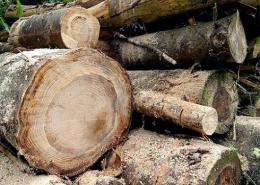Tree-ring science takes on the modern age

Whether it's learning how forests respond to environmental change or answering questions about the history of ancient cultures, trees continue to be a solid source of information for many kinds of researchers.
The science of tree rings -- known as dendrochronology -- has been a part of understanding forests for a hundred years. But more recently the process is being applied to answer much bigger questions than the ages of trees.
The basics are straightforward: as trees grow bigger, they add a bit of girth each year, resulting in a new ring around the trunk of the tree. Trees typically add thin rings during dry years and thick rings during wet years. Researchers typically collect pencil-shaped core samples from a group of trees and combine them to produce a precise sequence of tree rings over the life of the forest. By comparing living trees to their dead predecessors in the forest, the researchers build a bridge of knowledge to the past.
From these beginnings, scientists are asking big questions. One project from the Lamont-Doherty Earth Observatory has sampled trees all over the monsoon belt of Asia, from Japan to Pakistan, to understand the interactions between monsoons and climate processes. The project has taken five years and a team of researchers.
"As you get closer to the equator, you have a lot more species. That's one problem," said Lamont Observatory research professor Rosanne D'Arrigo. In addition, D'Arrigo said, the tropical regions don't really have a temperature season in which the trees shut down. And in places where monsoons drive the climate, she added, annual rings are formed during the drier time of year.
One result of the monsoon investigation uncovered the possible climatic roots of the downfall of the Ming dynasty in China and another found that volcanoes have shifted rainfall in Asia through the years, bringing dry years to central Asia but rain to southeastern countries.
Rings on trees cam come in many forms, and dendrochronologists can go hunting in many places. Dendroarcheologist Pearce Paul Creasman of the University of Arizona studies historical ship timbers to gain insight into the past. Creasman said that can offer chronological information on the date of construction, environmental information on the forests and climate of the time, as well as behavioral information on timber-use practices.
"In the 18th century, it took 6,000 trees to build one [large] ship," said Creasman. "There's so much there to learn beyond the date of the ship."
Creasman is also taking on a part of the world more associated with sand than with wood. He has started working in Egypt, and would like to build a more accurate timeline for ancient Egypt civilizations using dendrochronology.
"In the American Southwest, not much was known about the actual development until the 1930s," said Creasman. That's when A. E. Douglass, an astronomer by training, scoured Arizona for Ponderosa pine -- dead or alive -- to construct the first chronology, linking together different trees to make a timeline. Douglass's chronology stretched back nearly 500 years, and he worked with anthropologists to date timbers in pueblos in the Southwest.
Using those methods, Creasman wants to use wood to answer lingering questions about Egypt. With an arid climate, Egypt is full of wood in vaults or in boats that were buried with important people -- wood that could be used to understand more about the cultures of the past and fix exact dates to events.
"This would be a kind of holy grail for ancient Egypt. No one really knows how many years King Tut ruled, or how long it took to build the pyramids," said Creasman.
Many of the tree-ring labs like Arizona and Lamont-Doherty offer free open-source software to people who would like to analyze tree data themselves. Organized scientific efforts might not be able to sample trees quickly enough, so additional data could contribute information that would otherwise be lost.
"We're battling a few challenges -- one is deforestation," said D'Arrigo. "We feel urgency to take samples from remote sites before they're paved over."
Source: Inside Science News Service




















